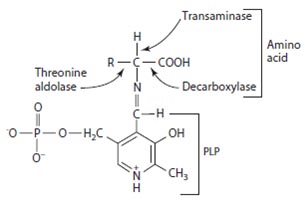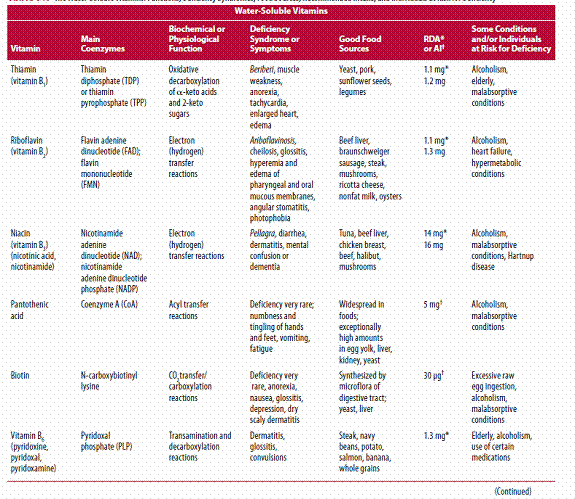
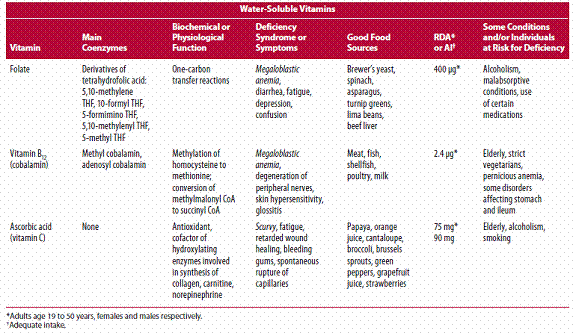

Fat-Soluble Vitamins
by J. Anderson and L. Young1 (8/08)
Quick Facts...
Vitamins are essential nutrients your body needs in small amounts for various roles in the human body. Vitamins are divided into two groups: water-soluble (B-complex and C) and fat-soluble (A, D, E and K). Unlike water-soluble vitamins that need regular replacement in the body, fat-soluble vitamins are stored in the liver and fatty tissues, and are eliminated much more slowly than water-soluble vitamins.
Because fat-soluble vitamins are stored for long periods, they generally pose a greater risk for toxicity than water-soluble vitamins when consumed in excess. Eating a normal, well-balanced diet will not lead to toxicity in otherwise healthy individuals. However, taking vitamin supplements that contain mega doses of vitamins A, D, E and K may lead to toxicity. Remember, the body only needs small amounts of any vitamin.
While diseases caused by a lack of fat-soluble vitamins are rare in the United States, symptoms of mild deficiency can develop without adequate amounts of vitamins in the diet. Additionally, some health problems may decrease the absorption of fat, and in turn, decrease the absorption of vitamins A, D, E and K. Consult your doctor about this.
Table 1 lists sources of fat-soluble vitamins, their basic functions in the body, major deficiency symptoms caused by a lack of these vitamins, and symptoms of over-consumption.
Vitamin A
Vitamin A, also called retinol, has many functions in the body. In addition to helping the eyes adjust to light changes, vitamin A plays an important role in bone growth, tooth development, reproduction, cell division and gene expression. Also, the skin, eyes and mucous membranes of the mouth, nose, throat and lungs depend on vitamin A to remain moist.
The best way to ensure your body gets enough vitamin A is to eat a variety of foods. Vitamin A is supplied primarily by certain foods of animal origin like dairy products, fish and liver. Some foods of plant origin contain beta-carotene, an antioxidant that the body converts to vitamin A. Beta-carotene, or provitamin A, comes from fruits and vegetables. Carrots, pumpkin, winter squash, dark green leafy vegetables and apricots are rich sources of beta-carotene.
The recommendation for vitamin A intake is expressed as micrograms (mcg) of retinol activity equivalents (RAE). Retinol activity equivalents account for the fact that the body converts only a portion of beta-carotene to retinol. One RAE equals 1 mcg of retinol or 12 mcg of beta-carotene (see Table 2).
True vitamin A deficiency in the United States is rare. Night blindness and very dry, rough skin may indicate a lack of vitamin A. Other signs of possible vitamin A deficiency include decreased resistance to infections, faulty tooth development, and slower bone growth.
In the United States, toxic or excess levels of vitamin A are of more concern than deficiencies. The tolerable upper intake level for adults is 3,000 mcg RAE. It would be difficult to reach this level consuming food alone. But some multivitamin supplements contain high doses of vitamin A. If you take a multivitamin, check the label to be sure the majority of vitamin A provided is in the form of beta-carotene, which appears to be safe. Symptoms of vitamin A toxicity include dry, itchy skin, headache, nausea, and loss of appetite. Signs of severe overuse over a short period of time include dizziness, blurred vision and slowed growth. Vitamin A toxicity also can cause severe birth defects and may increase the risk for hip fractures.
Physicians sometimes recommend that young infants take vitamin supplements that contain vitamin A. However, toddlers and children need protection from too much vitamin A due to their smaller body size. Typical foods eaten in large amounts by toddlers and children usually contain sufficient amounts of vitamin A. Provide a variety of foods for your children, and if in doubt, check with a pediatrician or Registered Dietitian.
|
Table 1: Vitamin facts. |
||||
|
Vitamin |
Source |
Physiological Functions |
Deficiency |
Overconsumption |
|
A (retinol) (provitamin A, such as beta carotene) |
Vitamin A: liver, vitamin A fortified milk
and dairy products, butter, whole milk, cheese, egg yolk. |
Helps to form skin and mucous membranes and keep them healthy, thus increasing resistance to infections; essential for night vision; promotes bones and tooth development. Beta carotene is an antioxidant and may protect against cancer. |
Mild: night blindness, diarrhea, intestinal
infections, impaired vision. |
Mild: nausea, irritability, blurred vision.
|
|
D |
Vitamin D-fortified dairy products, fortified margarine, fish oils, egg yolk. Synthesized by sunlight action on skin. |
Promotes hardening of bones and teeth, increases the absorption of calcium. |
Severe: rickets in children; osteomalacia in adults. |
Mild: nausea, weight loss, irritability. |
|
E |
Vegetable oil, margarine, butter, shortening, green and leafy vegetables, wheat germ, whole grain products, nuts, egg yolk, liver. |
Protects vitamins A and C and fatty acids; prevents damage to cell membranes. Antioxidant. |
Almost impossible to produce without starvation; possible anemia in low birth-weight infants. |
Nontoxic under normal conditions. |
|
K |
Dark green leafy vegetables, liver; also made by bacteria in the intestine. |
Helps blood to clot. |
Excessive bleeding. |
None reported. |
Vitamin D
Vitamin D plays a critical role in the bodyís use of calcium and phosphorous. It increases the amount of calcium absorbed from the small intestine and helps form and maintain bones. Children especially need adequate amounts of vitamin D to develop strong bones and healthy teeth.
The primary food sources of vitamin D are milk and other dairy products fortified with vitamin D. Vitamin D is also found in oily fish (e.g., herring, salmon and sardines) as well as in cod liver oil. In addition to the vitamin D provided by food, we obtain vitamin D through our skin which makes vitamin D in response to sunlight.
An Adequate Intake (AI) for has been established for vitamin D (see Table 2). The AIs for vitamin D appear as micrograms (mcg) of cholecalciferol. Ten mcg of cholecalciferol equals 400 International Units (IU).
Symptoms of vitamin D deficiency in growing
children include rickets (long, soft bowed legs) and flattening of the back of
the skull. Vitamin D deficiency in adults is called osteomalacia, which results
in muscular weakness and weak bones. These conditions are rare in the United
States.
The tolerable upper intake level for vitamin D is set at 50 mcg for people 1
year of age and older (see Table 3). High doses of vitamin D supplements coupled
with large amounts of fortified foods may cause accumulations in the liver and
produce signs of poisoning. Signs of vitamin D toxicity include excess calcium
in the blood, slowed mental and physical growth, decreased appetite, nausea and
vomiting.
It is important that infants and young children do not consume excess amounts of vitamin D regularly. Children exposed to the sun for 5 to 10 minutes daily will produce enough vitamin D. However, if children live in inner cities, wear clothes that cover most of their skin or live in northern climates where little sun is seen in the winter, then vitamin D deficiency may occur. Rather than give children a supplement, add fortified foods to their diet, such as vitamin D fortified milk and other dairy products.
Vitamin D deficiency has been associated with increased risk of common cancers, autoimmune diseases, hypertension and infectiouse disease. In the absence of adequate sun exposure, at least 800 to 1,000 IU of Vitamin D3 may be needed to reach the circulating level required to maximize Vitamin Dís beneficial health effects.
|
Table 2: Dietary Reference Intakes (DRI) for fat soluble vitamins. |
|||||||
|
|
Life Stage Group |
Vitamin A (mcg1) |
Vitamin A (IU) |
Vitamin D (mcg2) |
Vitamin D (IU) |
Vitamin E (mg a-TE3) |
Vitamin E (IU) |
|
Infants |
0.0-0.5 |
400* |
1333 |
5* |
200 |
4* |
6 |
|
0.5-1.0 |
500* |
1666 |
5* |
200 |
5* |
7.5 |
|
|
Children |
1-3 |
300 |
1000 |
5* |
200 |
6 |
9 |
|
4-8 |
400 |
1333 |
5* |
200 |
7 |
10.5 |
|
|
Males |
9-13 |
600 |
2000 |
5* |
200 |
11 |
16.5 |
|
14-18 |
900 |
3000 |
5* |
200 |
15 |
22.5 |
|
|
19-30 |
900 |
3000 |
5* |
200 |
15 |
22.5 |
|
|
31-50 |
900 |
3000 |
5* |
200 |
15 |
22.5 |
|
|
51-70 |
900 |
3000 |
10* |
400 |
15 |
22.5 |
|
|
71+ |
900 |
3000 |
15* |
600 |
15 |
22.5 |
|
|
Females |
9-13 |
600 |
2000 |
5* |
200 |
11 |
16.5 |
|
14-18 |
700 |
2333 |
5* |
200 |
15 |
22.5 |
|
|
19-30 |
700 |
2333 |
5* |
200 |
15 |
22.5 |
|
|
31-50 |
700 |
2333 |
5* |
200 |
15 |
22.5 |
|
|
51-70 |
700 |
2333 |
10* |
400 |
15 |
22.5 |
|
|
71+ |
700 |
2333 |
15* |
600 |
15 |
22.5 |
|
|
Pregnant |
<18 |
750 |
2500 |
5* |
200 |
15 |
22.5 |
|
19-30 |
770 |
2566 |
5* |
200 |
15 |
22.5 |
|
|
31-50 |
770 |
|
5* |
200 |
15 |
22.5 |
|
|
Lactating |
<18 |
1,300 |
4000 |
5* |
200 |
19 |
28.8 |
|
19-30 |
1,300 |
4333 |
5* |
200 |
19 |
28.8 |
|
|
31-50 |
1,300 |
4333 |
5* |
200 |
19 |
28.8 |
|
|
*Indicates an Adequate Intake (AI). All
other values are Recommended Dietary Allowance (RDA). |
|||||||
Vitamin E
Vitamin E acts as an antioxidant, protecting vitamins A and C, red blood cells and essential fatty acids from destruction. Research from a decade ago suggested that taking antioxidant supplements, vitamin E in particular, might help prevent heart disease and cancer. However, newer findings indicate that people who take antioxidant supplements are not better protected against heart disease and cancer than non-supplement users. On the other hand, there are many studies that show a link between regularly eating antioxidant-rich fruits and vegetables and a lower risk for heart disease, cancer and several other diseases.
The RDA for vitamin E is based on the most
active and usable form called alpha-tocopherol (see Table 2). One milligram of
alpha-tocopherol equals to 1.5 International Units (IU).About 60 percent of
vitamin E in the diet comes from vegetable oil or products made with vegetable
oils. Therefore, good food sources of vitamin E include vegetable oils and
margarines. Vitamin E is also found in fruits and vegetables, grains, nuts,
seeds and fortified cereals.
Vitamin E deficiency is rare. Cases of vitamin E deficiency only occur in
premature infants and people unable to absorb fats.
The tolerable upper intake levels for vitamin E are shown in Table 3. Large doses of vitamin E pose a hazard to people who take blood-thinning medications. People taking statin drugs are also not advised to take supplemental vitamin E because it may interfere with how the medication works.
Vitamin K
Naturally produced by the bacteria in the intestines, vitamin K plays an essential role in normal blood clotting and helps promote bone health.
Good food sources of vitamin K are green
vegetables such as turnip greens, spinach, cauliflower, cabbage and broccoli,
and certain vegetables oils including soybean oil, cottonseed oil, canola oil
and olive oil. Animal foods, in general, contain limited amounts of vitamin K.
To help ensure people receive sufficient amounts of vitamin K, an Adequate
Intake (AI) has been established for each age group (see Table 2).
Without sufficient amounts of vitamin K, hemorrhaging can occur. Deficiencies may appear in infants, or in people who take anticoagulants or antibiotic drugs. Newborn babies lack the intestinal bacteria to produce vitamin K and need a supplement for the first week. People on anticoagulant drugs (blood thinners) may become deficient in vitamin K, but should not change their vitamin K intake without consulting a physician because the effectiveness of the drug may be affected. People taking antibiotics may lack vitamin K temporarily because intestinal bacteria are sometimes killed as a result of long-term use of antibiotics. Also, people with chronic diarrhea may have problems absorbing sufficient amounts of vitamin K through the intestine and should consult their physician to determine if supplementation is necessary.
Although a tolerable upper intake level has not been established for vitamin K, excessive amounts can cause the breakdown of red blood cells and liver damage. Large doses are not advised.
|
Table 3. Tolerable upper intake levels (UL)*. |
|||||
|
|
Life Stage Group |
Vitamin A (mcg) |
Vitamin D (mcg) |
Vitamin E (mg a-TE) |
|
|
Infants |
0.0-0.5 |
600 |
25 |
ND1 |
|
|
0.5-1.0 |
600 |
25 |
ND |
||
|
Children |
1-3 |
600 |
50 |
200 |
|
|
4-8 |
900 |
50 |
300 |
||
|
Males/Females |
9-13 |
1,700 |
50 |
600 |
|
|
14-18 |
2,800 |
50 |
800 |
||
|
19-70 |
3,000 |
50 |
1,000 |
||
|
>71 |
3,000 |
50 |
1,000 |
||
|
Pregnant & Lactating |
<18 |
2,800 |
50 |
800 |
|
|
19-50 |
3,000 |
50 |
1,000 |
||
|
*A UL for vitamin K was not established. |
|||||
Standards for Measuring Intake
Vitamin requirements are expressed in small units. Most are given in milligrams (mg) or micrograms (mcg). When comparing vitamin amounts on labels, note whether values are in micrograms (mcg), milligrams (mg) or International Units (IU). Make sure you compare the same units.
Dietary Reference Intakes (DRI) are dietary standards for desirable and/or safe vitamin intake levels published by the Food and Nutrition Board of the National Academy of Sciences National Research Council. DRIs include three sets of values: recommended dietary allowances (referred to as RDAs) which are intended to meet the nutrient needs of healthy individuals; tolerable upper intake levels (UL) which are designed to help people avoid harmful effects caused by consuming too much of a nutrient; and adequate intakes (AI), which are established when there is not enough scientific evidence to set an RDA and are based on diets known to be nutritionally adequate for U.S. and Canadian populations. Table 2 lists the recommended amounts of fat-soluble vitamins that individuals in the United States need daily for good health. Table 3 provides the tolerable upper intake levels.
References
1 J. Anderson, Colorado State University Extension food and nutrition specialist and professor, food science and human nutrition; and L. Young, M.S., former graduate student. 7/96. Revised 8/08.
Water-Soluble Vitamins
by J. Anderson and L. Young1 (Revised 8/08)
Quick Facts...
Vitamins are essential nutrients found in foods. The requirements are small but they perform specific and vital functions essential for maintaining health.
The two types of vitamins are classified by the materials in which they will dissolve. Fat-soluble vitamins -- vitamins A, D, E and K -- dissolve in fat before they are absorbed in the blood stream to carry out their functions. Excesses of these vitamins are stored in the liver. Because they are stored, they are not needed every day in the diet.
By contrast, water-soluble vitamins dissolve in water and are not stored; they are eliminated in urine. We need a continuous supply of them in our diets. The water-soluble vitamins are the B-complex group and vitamin C.
Water-soluble vitamins are easily destroyed or washed out during food storage or preparation. Proper storage and preparation of food can minimize vitamin loss. To reduce vitamin loss, refrigerate fresh produce, keep milk and grains away from strong light, and use the cooking water from vegetables to prepare soups. (See Table 1.)
Vitamin B-Complex
Eight of the water-soluble vitamins are known as the B-complex group: thiamin (vitamin B1), riboflavin (vitamin B2), niacin, vitamin B6, folate, vitamin B12, biotin and pantothenic acid. These vitamins are widely distributed in foods. (See Table 2.) Their influence is felt in many parts of the body. They function as coenzymes that help the body obtain energy from food. They also are important for normal appetite, good vision, healthy skin, healthy nervous system and red blood cell formation.
Beriberi, pellagra and pernicious anemia are three well-known B-vitamin deficiencies. These diseases are not a problem in the United States, but occasionally they occur when people omit certain foods or overeat certain foods at the expense of others. Alcoholics are especially prone to thiamin deficiency because alcohol replaces food.Vegans will need a B12 supplement.
When grains and grain products are refined, essential nutrients lost during processing are put back into these foods through a process called enrichment. Among the nutrients added during the enrichment process are thiamin, niacin, riboflavin, folate and iron. Some examples of enriched grain products are white rice, many breakfast cereals, white flour, breads, and pasta.
For some populations, rice is the main dietary staple. When "polishing" rice (removing its outer layers) became popular, thiamin deficiency, or beriberi, increased significantly.
In the early 1900s, the most widespread vitamin deficiency disease in the United States was pellagra, or niacin deficiency. At that time, pellagra caused thousands of deaths and many cases of mental and physical illness among the poor in the Southeast. The enrichment of flour, rice, and wheat products helped to eliminate the deficiency problems found in people who depended on these food items for most of their daily calories.
Table 3 summarizes the new standards for nutrient recommendations: The Dietary Reference Intake (DRI). The recommendations meet the average daily nutritional needs of all healthy people. To ensure the needs of all in the population, the DRI usually exceeds the requirements for most people. They do not cover requirements for illness and special health disorders.
|
Table 1: Water-soluble vitamins and their characteristics. |
||||
|
Common food sources |
Major functions |
Deficiency symptoms |
Overconsumption symptoms |
Stability in foods |
|
Vitamin C (ascorbic acid) |
||||
|
Citrus fruits, broccoli, strawberries, melon, green pepper, tomatoes, dark green vegetables, potatoes. |
Formation of collagen (a component of tissues), helps hold them together; wound healing; maintaining blood vessels, bones, teeth; absorption of iron, calcium, folacin; production of brain hormones, immune factors; antioxidant. |
Bleeding gums; wounds don't heal; bruise easily; dry, rough skin; scurvy; sore joints and bones; increased infections. |
Nontoxic under normal conditions; rebound scurvy when high doses discontinued; diarrhea, bloating, cramps; increased incidence of kidney stones. |
Most unstable under heat, drying, storage; very soluble in water, leaches out of some vegetables during cooking; alkalinity (baking soda) destroys vitamin C. |
|
Thiamin (vitamin B1 ) |
||||
|
Pork, liver, whole grains, enriched grain products, peas, meat, legumes. |
Helps release energy from foods; promotes normal appetite; important in function of nervous system. |
Mental confusion; muscle weakness, wasting; edema; impaired growth; beriberi. |
None known. |
Losses depend on cooking method, length, alkalinity of cooking medium; destroyed by sulfite used to treat dried fruits such as apricots; dissolves in cooking water. |
|
Riboflavin (vitamin B2) |
||||
|
Liver, milk, dark green vegetables, whole and enriched grain products, eggs. |
Helps release energy from foods; promotes good vision, healthy skin. |
Cracks at corners of mouth; dermatitis around nose and lips; eyes sensitive to light. |
None known. |
Sensitive to light; unstable in alkaline solutions. |
|
Niacin (nicotinamide, nicotinic acid) |
||||
|
Liver, fish, poultry, meat, peanuts, whole and enriched grain products. |
Energy production from foods; aids digestion, promotes normal appetite; promotes healthy skin, nerves. |
Skin disorders; diarrhea; weakness; mental confusion; irritability. |
Abnormal liver function; cramps; nausea; irritability. |
|
|
Vitamin B6 (pyridoxine, pyridoxal, pyridoxamine) |
||||
|
Pork, meats, whole grains and cereals, legumes, green, leafy vegetables. |
Aids in protein metabolism, absorption; aids in red blood cell formation; helps body use fats. |
Skin disorders, dermatitis, cracks at corners of mouth; irritability; anemia; kidney stones; nausea; smooth tongue. |
None known. |
Considerable losses during cooking. |
|
Folacin (folic acid) |
||||
|
Liver, kidney, dark green leafy vegetables, meats, fish, whole grains, fortified grains and cereals, legumes, citrus fruits. |
Aids in protein metabolism; promotes red blood cell formation; prevents birth defects of spine, brain; lowers homocystein levels and thus coronary heart disease risk. |
Anemia; smooth tongue; diarrhea. |
May mask vitamin B12 deficiency (pernicious anemia). |
Easily destroyed by storing, cooking and other processing. |
|
Vitamin B12 |
||||
|
Found only in animal foods: meats, liver, kidney, fish, eggs, milk and milk products, oysters, shellfish. |
Aids in building of genetic material; aids in development of normal red blood cells; maintenance of nervous system. |
Pernicious anemia, anemia; neurological disorders; degeneration of peripheral nerves that may cause numbness, tingling in fingers and toes. |
None known. |
|
|
Pantothenic acid |
||||
|
Liver, kidney, meats, egg yolk, whole grains, legumes; also made by intestinal bacteria. |
Involved in energy production; aids in formation of hormones. |
Uncommon due to availability in most foods; fatigue; nausea, abdominal cramps; difficulty sleeping. |
None known. |
About half of pantothenic acid is lost in the milling of grains and heavily refined foods. |
|
Biotin |
||||
|
Liver, kidney, egg yolk, milk, most fresh vegetables, also made by intestinal bacteria. |
Helps release energy from carbohydrates; aids in fat synthesis. |
Uncommon under normal circumstances; fatigue; loss of appetite, nausea, vomiting; depression; muscle pains; anemia. |
None known. |
|
|
Table 2: Major food sources of water-soluble vitamins. |
||||||
|
|
Grains |
Fruits |
Vegetables |
Meats, Eggs |
Legumes, Nuts, Seeds |
Milk, Dairy |
|
Thiamin |
X |
|
|
X |
X |
|
|
Riboflavin |
X |
|
|
|
|
X |
|
Niacin |
X |
|
|
X |
X |
|
|
Biotin |
|
|
X |
X |
X |
|
|
Pyridoxine |
X |
|
|
X |
|
X |
|
Pantothenic acid |
X |
X |
X |
X |
X |
X |
|
Vitamin B12 |
|
|
|
X |
|
X |
|
Folate |
X |
|
X |
|
|
|
|
Vitamin C |
|
X |
X |
|
|
|
|
Table 3: Dietary reference intakes (DRI). Selected recommended levels for individual intakes. |
||||
|
Nutrient |
RDA or A1 |
|
||
|
(ages 19-50 yrs) |
|
|||
|
Male |
Female |
|
|
|
|
Thiamin (mg) |
1.2 |
1.1 |
|
|
|
Riboflavin (mg) |
1.3 |
1.1 |
|
|
|
Niacin (mg) |
16 |
14 |
|
|
|
Vitamin B6 (mg) |
1.3 |
1.3 |
|
|
|
Folate (mcg) |
400 |
400 |
|
|
|
Vitamin B12 (mcg) |
2.4* |
2.4* |
|
|
|
Pantothenic acid (mg) |
5* |
5* |
|
|
|
Biotin (mcg) |
30* |
30* |
|
|
|
Vitamin C (mg) |
90 |
75 |
|
|
|
(mg = milligrams, mcg = micrograms) |
||||
Vitamin C
Why do we need vitamin C? Like the other vitamins, the body needs vitamin C to keep it in good working order. Also known as ascorbic acid, vitamin C helps hold body cells together, aids in wound healing, assists in bone and tooth formation, strengthens the blood vessel walls, is vital for the function of the immune system, and improves absorption and utilization of iron. It also helps prevent nutritional ailments such as scurvy, the disease that did the most to bring public attention to vitamin deficiency diseases.
Our bodies cannot make vitamin C. Therefore, every day we must eat foods containing this vitamin. Although the body has a constant need for vitamin C, it has a limited storage capacity. A regular and adequate intake is essential.
Eating vitamin C-rich foods is the best method to ensure an adequate intake of this vitamin. While many common foods contain vitamin C, the best food sources are citrus fruits. One orange, a kiwi fruit, 6 oz. of grapefruit juice or 1/3 cup of chopped sweet red pepper each supply enough vitamin C for one day.
Some conditions have been shown to increase vitamin C requirements. They are:
The controversy over megadoses of vitamin C to prevent or cure the common cold and other disorders has not been resolved. Vitamin supplements will not necessarily provide extra energy, clear up skin problems, or prevent and cure the common cold, heart disease, and cancer. Unlike pellagra, beriberi, or scurvy, these problems are not the result of a vitamin deficiency. What is known is that the only disease a vitamin will cure is the one caused by a deficiency of that vitamin.
Vitamin C also serves as an antioxidant. It works with vitamin E as a free-radical scavenger. Studies suggest that vitamin C may reduce the risk of certain cancers, heart disease and cataracts. Research continues to document the degree of these effects.
Definitions
Dietary Reference Intake (DRI): The new standards for nutrient recommendations that can be used to plan and assess diets for healthy people. Think of Dietary Reference Intakes as the umbrella term that includes the following values.
Estimated Average Requirement (EAR): A nutrient intake value that is estimated to meet the requirement of half the healthy individuals in the group. It is used to assess nutritional adequacy of intakes of population groups. In addition, EARs are used to calculate RDAs.
Recommended Dietary Allowance (RDA): This value is a goal for individuals and is based on the EAR. It is the daily dietary intake level that is sufficient to meet the nutrient requirement of 97 to 98 percent of all healthy individuals in a group. If an EAR cannot be set, no RDA value can be proposed.
Adequate Intake (AI): This is used when an RDA cannot be determined. A recommended daily intake level based on an observed or experimentally determined approximation of nutrient intake for a group (or groups) of healthy people.
Tolerable Upper Intake Level (UL): The highest level of daily nutrient intake that is likely to pose no risks of adverse health effects to almost all individuals in the general population. As intake increases above the UL, the risk of adverse effects increases.
Source: Food Insight, September/October 1998.
References
1J. Anderson, Colorado State University Extension foods and nutrition specialist and professor; and L. Young, M.S., former graduate student. 3/02. Revised 8/08.



Vitamin A

Vitamin D
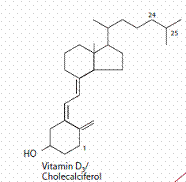
Vitamin E
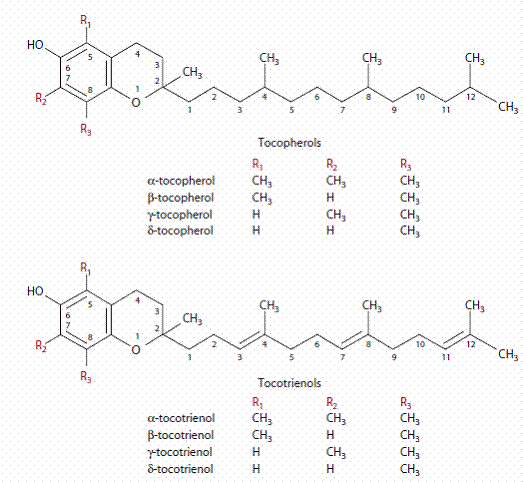
Vitamin K
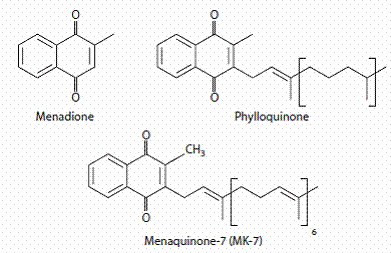
Vitamin C

Thiamine

Riboflavin
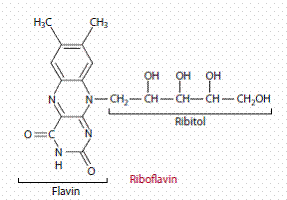
Niacin

Pentothenate

Biotin
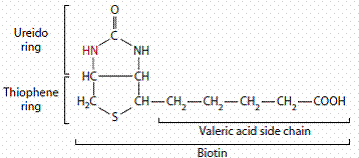
Folic acid

Vitamin B12
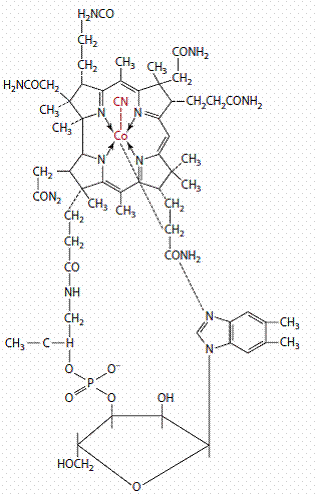
Vitamin B6
